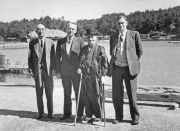Let us tell you the tahitian pearl story...
The pearl has passed through the ages since the dawn of time. Many ancient peoples such as Hindus, Egyptians, Greeks, Romans or Arabs evoke this gem of great value through their culture.
Chinese inscriptions dating back to 2,300 BC show that pearls were already considered to be jewels of nature at that time.
Thanks to their Polynesian possessions, the French were among the first to discover the pearls of Tahiti and soon began to trade them. However, the reserves of pearl oysters quickly depleted in the early 19th century due to the impressive amounts of mother-of-pearl demanded by the buttonhole industry.
Then, more than a hundred years ago, three men, who did not know each other, true pioneers in the field, Tokichi Nishikawa, Tatsuhei Mise and Kokichi Mikimoto, respectively biologist in the Imperial Japanese Navy, carpenter and son of a merchant, imagined almost simultaneously a new brilliant process to obtain pearls artificially: pearl farming. These three characters are considered the fathers of modern pearl culture.


Cultured pearls
Cultured pearls were not discovered a few decades ago. No, the cultivation of the pearl is quite recent but the use of the pearl is very old. So here's a little story of the precious pearl, whether cultured or not. This story really brings out the stakes and the value that is around the precious pearl market.
The first uses of pearls
The pearl has long been a sign of wealth and prestige. Indeed, men quickly noticed its rarity as well as its dazzling beauty. This is why more than four thousand years before the beginning of our era, there are already signs that peoples were using pearls to distinguish themselves and show their wealth. Of course, pearls were first used in coastal countries and near the Pacific. It is in this ocean that half of the world's pearls exist and are produced. Pacific water is indeed a water favorable to the cultivation and production of pearls thanks to oysters.
It is in China that we can record the first appearances of the pearl in society. It was extremely rare at the time because no one had the innovations to explore the seabed and discover pearl oysters. Only a few coastal villages were home to pearl fishermen who throughout their lives searched for pearls underwater. Passing on their knowledge from generation to generation, these divers have developed exceptional diving skills without any equipment.
At that time, the pearl was unknown in Europe. After China, it is in India that we see references to precious pearls. Indeed, it would be the god Krishna who according to the Hindu religion would have discovered the first precious pearl.
Expansion of the use of the precious pearl
It was only a few centuries before the beginning of our era that the pearl arrived in Europe. At that time it was still the princes and high dignitaries who could afford to import pearls from Asia. Thus, Cleopatra possessed many pearls that increased the jealousy of her competitors among kings and emperors.
In the Near and Middle East, the pearl has also grown a lot. Indeed, according to the Quran, the precious pearl would be a gift from God to men, and therefore a sign of the omnipotence of God, represented by the dazzling beauty of the pearl.
It was also during the Middle Ages that the trade in freshwater pearls developed. Especially in America where Indian chiefs pay other tribes with precious pearls.
Also in America, from the beginning of the16th century Europeans will rediscover pearls and export astronomical quantities to Europe. These quantities of pearl quickly brought down its value although it was still high. So European demand grew incredibly and quickly all the pearls of America were sold. In addition, pollution from industry events has led to a rapid decline in the reproduction of oysters. The world's oyster population has fallen sharply and this decline has influenced the price of pearls on the European market.
During the same period, Swedish and French researchers in particular will look for techniques to fill this important decline of pearls. Indeed, pearls are a jewel of nature and it would be a shame to lose this jewel in this way.
These two Swedish and French researchers will develop the first techniques for growing pearls. These techniques are then only experimental. Then, for nearly fifty years, after the death of these researchers, the pearl will lose its luster. The divisions linked to geopolitical influence in the Pacific have reduced the harvest of pearls to nothing. The pearl is almost forgotten.
Renaissance of the pearl by culture
It was only after the Second World War that the Japanese got their hands on the works of our two European researchers. In peacetime, these Japanese led by Kokichi Mikimoto will develop the technique now used to grow pearls. Thanks to previous work, Kokichi Mikimoto has for the first time introduced an irritating object into special oysters. He therefore noticed that the oyster could form a pearl from this non-sea object.
Thus, in a few years the pearl trade has grown considerably again all over the world. Led by Japanese, researchers from all over the world have at the death of Kokichi Mikimoto deepened this work and created the pearl culture that exists today.
Now all the pearls come from cultures. However, each farm has its own specificities that allow to produce different pearls, beads more or less round, more or less shiny, etc.
